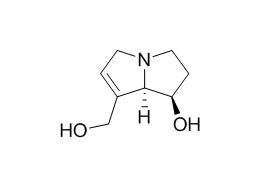Retronecine
Retronecine acts as the better competitor for the competitive inhibition of antibodies to Retronecine. Retronecine can be metabolized to form DHP by rat liver microsomal enzymes and interacts with DNA to produce DHP-DNA adducts and Retronecine N-oxide undergoes the biotransformation to the parent compound, Retronecine.
Inquire / Order:
manager@chemfaces.com
Technical Inquiries:
service@chemfaces.com
Tel:
+86-27-84237783
Fax:
+86-27-84254680
Address:
1 Building, No. 83, CheCheng Rd., Wuhan Economic and Technological Development Zone, Wuhan, Hubei 430056, PRC
Providing storage is as stated on the product vial and the vial is kept tightly sealed, the product can be stored for up to
24 months(2-8C).
Wherever possible, you should prepare and use solutions on the same day. However, if you need to make up stock solutions in advance, we recommend that you store the solution as aliquots in tightly sealed vials at -20C. Generally, these will be useable for up to two weeks. Before use, and prior to opening the vial we recommend that you allow your product to equilibrate to room temperature for at least 1 hour.
Need more advice on solubility, usage and handling? Please email to: service@chemfaces.com
The packaging of the product may have turned upside down during transportation, resulting in the natural compounds adhering to the neck or cap of the vial. take the vial out of its packaging and gently shake to let the compounds fall to the bottom of the vial. for liquid products, centrifuge at 200-500 RPM to gather the liquid at the bottom of the vial. try to avoid loss or contamination during handling.
Appl. Sci.2020, 10(5),1713.
Sci Rep.2024, 14(1):28864.
Applied Biological Chemistry2024, 67:66.
Antioxidants (Basel).2020, 9(2):E120
Food Chem.2019, 279:80-87
Pharmacogn Mag.2015, 11:S585-91
Eur Endod J.2020, 5(1):23-27.
Oncol Rep.2019, 41(4):2453-2463
Pharmacognosy Magazine2017, 13(52):868-874
Korean Journal of Pharmacognosy2014, 113-120
Related and Featured Products
Toxicol Ind Health. 2008 Apr;24(3):181-8.
Metabolic activation of retronecine and retronecine N-oxide - formation of DHP-derived DNA adducts.[Pubmed:
18842697]
Retronecine is the necine base and the structurally smallest chemical of the Retronecine-type pyrrolizidine alkaloids. Although it has been reported that microsomal metabolism of Retronecine generated DHP as a metabolite, it was yet not known whether metabolism of Retronecine in vivo could generate DHP-derived DNA adducts and if formed, whether or not the levels of DNA adducts were comparable with those formed from the other tumorigenic Retronecine-type pyrrolizidine alkaloids, such as riddelliine, retrorsine, and monocrotaline.
METHODS AND RESULTS:
In this investigation, the in-vitro and in-vivo metabolic activation of Retronecine was studied. Rat liver microsomal metabolism of Retronecine in the presence of calf thymus DNA resulted in the formation of a set of DHP-DNA adducts. The metabolism of Retronecine N-oxide under similar conditions also formed the similar set of DHP-DNA adducts. The level of DNA adducts from Retronecine was enhanced when metabolism by liver microsomes from phenobarbital (PB)-induced rats were used. The DHP-DNA adducts were also found in the liver DNA of female F344 rats treated with Retronecine or Retronecine N-oxide. The highest level of the total DHP-DNA adducts was found in liver DNA from the rats treated with dehydroRetronecine (DHR). The order of the levels of DNA adducts in the liver DNA samples from rats treated with various pyrrolizidine alkaloids was: DHR > riddelliine > riddelliine N-oxide >> Retronecine > Retronecine N-oxide.
CONCLUSIONS:
The results indicate that 1) Retronecine can be metabolized to form DHP by rat liver microsomal enzymes and interacts with DNA to produce DHP-DNA adducts and 2) Retronecine N-oxide undergoes the biotransformation to the parent compound, Retronecine.
Nat Prod Commun. 2013 Nov;8(11):1545-6.
Further evidence on the intramolecular lactonization in rat liver microsomal metabolism of 12-O-acetylated retronecine-type pyrrolizidine alkaloids.[Pubmed:
24427937]
We have previously found evidence of intramolecular lactonization in rat liver microsomal metabolism of isoline, a 12-O-acetylated pyrrolizidine alkaloid.
METHODS AND RESULTS:
In this study, the metabolism of another 12-O-acetylated pyrrolizidine alkaloid, acetylduciformine, by the proposed transformation pathway was investigated under the same incubation conditions. Two deacetylated metabolites from acetylduciformine were isolated and purified by chromatographic methods, and further characterized based on their physical properties and spectral data. One metabolite (lankongensisine A) was the lactone of another one (duciformine).
CONCLUSIONS:
Both compounds were first obtained as hydrolyzed metabolites from acetylduciformine by rat liver microsomes. More importantly, the present study provided further evidence for the intramolecular lactonization in the microsomal metabolism of 12-O-acetylated Retronecine-type PAs.
Toxicon. 1989;27(9):1059-64.
A competitive enzyme-linked immunosorbent assay (ELISA) to detect retronecine and monocrotaline in vitro.[Pubmed:
2508272]
METHODS AND RESULTS:
Antibodies to the nonesterified pyrrolizidine nucleus, Retronecine (155 mol.wt), were produced in rabbits and detected using an avidin-biotin antibody ELISA. A competitive ELISA for the detection of Retronecine and the cyclic diester monocrotaline was also developed using the antiserum produced against the hapten conjugate, Retronecine-bovine serum albumin. Retronecine was obtained by hydrolysis of monocrotaline, succinylated and directly coupled to bovine serum albumin or ovalbumin. Antibodies to the pyrrolizidine nucleus, Retronecine, can be detected within 5 min after the addition of substrate using the avidin-biotin ELISA.
CONCLUSIONS:
Competitive inhibition of antibodies to Retronecine is obtained by the addition of known amounts (0-11.42 micrograms/microliters) of either the homologous antigen, Retronecine, or the heterologous antigen, monocrotaline, however, Retronecine acts as the better competitor.



